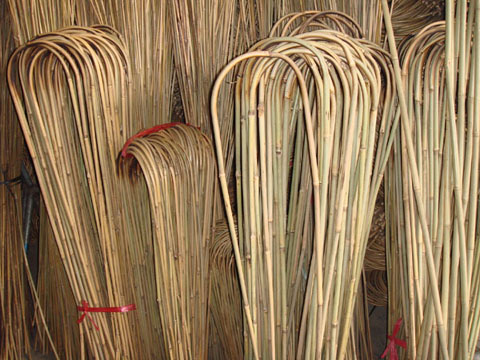Q&A Special: How to Bend Bamboo
Every once in a while someone sends me a materials-related question and I get to sit at a local wing joint on a rainy day, my non-typing hand covered in piquant buffalo sauce and stringy, ranch-coated celery fragments, watching multiple football games simultaneously while happily dispensing advice on subjects about which I may or may not have any expertise … and it is glorious. In the interest of sharing knowledge and offering a forum for people with actual experience and/or information concerning the question to contribute what they know (which I hope you’ll do in the comments section) please allow me to present a recent query and answer for your infotainment:
Dear Alli,
We are students of product design and are interested in knowing about the methodology used in bending bamboo or lamboo for shaping.
Can you pls how this is done–is it by air pressure or water pressure or by direct heating?
Saroj
India
Hi Saroj,
Although it’s technically a grass, bamboo acts a lot like wood, in that it performs well in tension and it’s fibrous and fast-growing. And just as with its arboreal cousin, people bend bamboo in order to make furniture, walking canes, or perhaps they bend it for more complicated reasons such as in order to feel capable of imposing their will on the natural world. And from what I can tell, all of these bending operations, whether the object of your deformation is a piece of plywood or a length of bamboo, require the application of heat.
Image courtesy made-in-china.com
While I have seen people steam the bamboo or apply heated, wet rags then bend and clamp it into position once the material has absorbed enough moisture to become pliable, I think it’s also possible to just blast the stuff with a blowtorch. (I found a highly instructive video of a craftsman in Mexico bending bamboo using said tool, upon which I plan to base this advice). I’ll include the video but for those of you on YouTube restriction, here’s how it’s done:
First, the bamboo is rotated rapidly and heated with a blowtorch that the craftsman moves continuously, allowing him to apply heat to the entire length of the bamboo stalk without scorching it. He polishes the stalk with a rag then applies heat a second time, as though to lock in the polish.
Next, one end of the stalk gets sealed off and the hollow tube is filled with sand. I think the sand acts like a flexible internal reinforcing for the bamboo as it bends, preventing it from splitting, checking, or creasing as it bends. The sealed end is placed in a clamp, whereupon more fast-moving blowtorch heat gets applied as the craftsman bends the stalk into position.
After the bamboo has cooled, he is able to unstopper the ends and drain the sand out; and BAM! that craftsman has himself a perfectly curved piece of bamboo.
Lamboo, a material I have written about before, which is basically glu-lam made from bamboo, can also be bent, although I’d imagine that the process depends on the characteristics of the resin involved in the manufacture of the material, as well as how it’s configured etc.
There is also Bendywood, a sort of permanently flexible, slightly dehydrated wood product. I’m not sure if similar techniques could be applied to bamboo but it would be fun to try!
Saroj, I hope that this answers your question or that it at least provides some content for other informed people to disagree with or correct in the comments!
Sincerely,
Alli
I have filed this Q&A Special under WOOD because that is where I always file bamboo. HAH!

















Leave a Wordpress Comment: